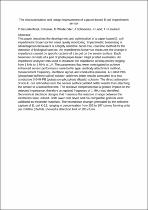 ResearchSpace
ResearchSpace
The characterisation and design improvement of a paper-based E.coli impedimetric sensor
JavaScript is disabled for your browser. Some features of this site may not work without it.
- ResearchSpace
- →
- Research Publications/Outputs
- →
- Conference Publications
- →
- View Item
| dc.contributor.author |
Bezuidenhout, Petrone H

|
|
| dc.contributor.author |
Kumar, Raju

|
|
| dc.contributor.author |
Wiederoder, M

|
|
| dc.contributor.author |
Schoeman, J

|
|
| dc.contributor.author |
Land, Kevin J

|
|
| dc.contributor.author |
Joubert, T-H

|
|
| dc.date.accessioned | 2018-08-22T09:37:38Z | |
| dc.date.available | 2018-08-22T09:37:38Z | |
| dc.date.issued | 2017-02 | |
| dc.identifier.citation | Bezuidenhout, PH, Kumar, R, Wiederoder, M. et.al. 2017. The characterisation and design improvement of a paper-based E.coli impedimetric sensor. Proceedings Volume 10036, Fourth Conference on Sensors, MEMS, and Electro-Optic Systems; 100360L (2017), 12-14 September 2016, Skukuza, Kruger National Park, South Africa, 6pp. | en_US |
| dc.identifier.uri | Doi: 10.1117/12.2245754 | |
| dc.identifier.uri | http://hdl.handle.net/10204/10378 | |
| dc.description | Copyright: 2017 SPIE. Due to copyright restrictions, the attached PDF file only contains the abstract of the full text item. For access to the full text item, kindly consult the publisher's website. | en_US |
| dc.description.abstract | This paper describes the development and optimisation of a paper-based E. coli impedimetric biosensor for water quality monitoring. Impedimetric biosensing is advantageous because it is a highly sensitive, label-free, real-time method for the detection of biological species. An impedimetric biosensor measures the change in impedance caused by specific capture of a target on the sensor surface. Each biosensor consists of a pair of photo paper-based inkjet printed electrodes. An impedance analyser was used to measure the impedance at frequencies ranging from 1 kHz to 1 MHz at 1V. The parameters that were investigated to achieve enhanced sensor performance were buffer type, antibody attachment method, measurement frequency, electrode layout, and conductive material. A 0.04M PBS (phosphate buffered saline) solution achieves better results compared to a less conductive 0.04M PB (potassium phosphate dibasic) solution. The direct adsorption of anti-E. coli antibodies onto the sensor surface yielded better results than attaching the sensor to a lateral flow test. The resistive component had a greater impact on the detected impedance, therefore an optimal frequency of 1 MHz was identified. Geometrical electrode designs that maximise the resistive change between the electrodes were utilised. Both lower cost silver and bio-compatible gold ink were validated as electrode materials. The impedance change generated by the selective capture of E. coli K-12, ranging in concentration from 103 to 107 colony forming units per millilitre (cfu/ml), showed a detection limit of 105 cfu/ml. | en_US |
| dc.language.iso | en | en_US |
| dc.publisher | SPIE | en_US |
| dc.relation.ispartofseries | Worklist;20208 | |
| dc.subject | Water sustainability | en_US |
| dc.subject | Biosensors | en_US |
| dc.subject | Water quality monitoring | en_US |
| dc.title | The characterisation and design improvement of a paper-based E.coli impedimetric sensor | en_US |
| dc.type | Conference Presentation | en_US |
| dc.identifier.apacitation | Bezuidenhout, P. H., Kumar, R., Wiederoder, M., Schoeman, J., Land, K. J., & Joubert, T. (2017). The characterisation and design improvement of a paper-based E.coli impedimetric sensor. SPIE. http://hdl.handle.net/10204/10378 | en_ZA |
| dc.identifier.chicagocitation | Bezuidenhout, Petrone H, Raju Kumar, M Wiederoder, J Schoeman, Kevin J Land, and T-H Joubert. "The characterisation and design improvement of a paper-based E.coli impedimetric sensor." (2017): http://hdl.handle.net/10204/10378 | en_ZA |
| dc.identifier.vancouvercitation | Bezuidenhout PH, Kumar R, Wiederoder M, Schoeman J, Land KJ, Joubert T, The characterisation and design improvement of a paper-based E.coli impedimetric sensor; SPIE; 2017. http://hdl.handle.net/10204/10378 . | en_ZA |
| dc.identifier.ris | TY - Conference Presentation AU - Bezuidenhout, Petrone H AU - Kumar, Raju AU - Wiederoder, M AU - Schoeman, J AU - Land, Kevin J AU - Joubert, T-H AB - This paper describes the development and optimisation of a paper-based E. coli impedimetric biosensor for water quality monitoring. Impedimetric biosensing is advantageous because it is a highly sensitive, label-free, real-time method for the detection of biological species. An impedimetric biosensor measures the change in impedance caused by specific capture of a target on the sensor surface. Each biosensor consists of a pair of photo paper-based inkjet printed electrodes. An impedance analyser was used to measure the impedance at frequencies ranging from 1 kHz to 1 MHz at 1V. The parameters that were investigated to achieve enhanced sensor performance were buffer type, antibody attachment method, measurement frequency, electrode layout, and conductive material. A 0.04M PBS (phosphate buffered saline) solution achieves better results compared to a less conductive 0.04M PB (potassium phosphate dibasic) solution. The direct adsorption of anti-E. coli antibodies onto the sensor surface yielded better results than attaching the sensor to a lateral flow test. The resistive component had a greater impact on the detected impedance, therefore an optimal frequency of 1 MHz was identified. Geometrical electrode designs that maximise the resistive change between the electrodes were utilised. Both lower cost silver and bio-compatible gold ink were validated as electrode materials. The impedance change generated by the selective capture of E. coli K-12, ranging in concentration from 103 to 107 colony forming units per millilitre (cfu/ml), showed a detection limit of 105 cfu/ml. DA - 2017-02 DB - ResearchSpace DP - CSIR KW - Water sustainability KW - Biosensors KW - Water quality monitoring LK - https://researchspace.csir.co.za PY - 2017 T1 - The characterisation and design improvement of a paper-based E.coli impedimetric sensor TI - The characterisation and design improvement of a paper-based E.coli impedimetric sensor UR - http://hdl.handle.net/10204/10378 ER - | en_ZA |





